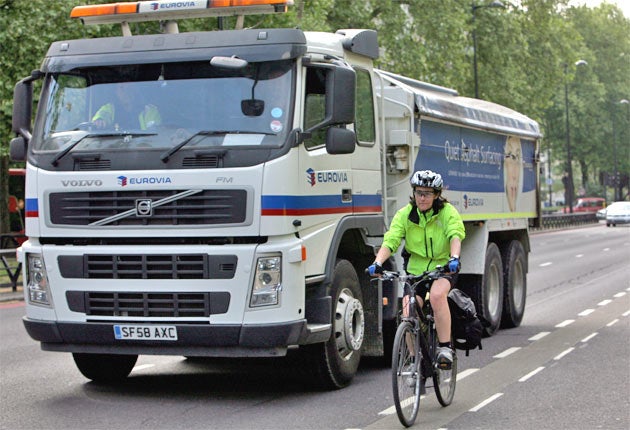A trucker's view of life in the cycle lane
Simon Usborne swaps two wheels for 14 to see how technology may help age-old enemies share the roads in harmony

If Britain's roads are becoming a battleground, then Lee Ruggles is on the frontline, waging war from behind the controls of a 32-ton killing machine. When he offers a ham-thick arm from the cab of his tipper truck, I decide not to reveal my preferred mode of transport lest he crush my weedy cyclist's hand.
Avoiding eye contact as I climb into the passenger seat, I keep quiet as we roll west out of a dusty depot in Dagenham towards the central London killing fields of Parliament Square, Park Lane and the notorious gyratory of death known as Hyde Park Corner.
As an air of fear pollutes the roads and bike lanes of our towns and cities, lorry drivers have been accused of terrorising two-wheelers, leaving a trail of death and misery in the tracks of bone-crushing tyres. In response, The Independent has launched a campaign to improve the safety of the country's growing number of cyclists. Statistics show that, on balance, they are safer than ever, but lorries are involved in a disproportionate number of accidents. Yesterday, friends of a Japanese woman named only as Naoko paid tribute to the 35-year-old, who was killed last Thursday in a collision with a lorry in West London.
Ruggles has been driving trucks for 12 years and now works for Eurovia Roadstone, which delivers asphalt from its Essex base. Concerned by what they see as a demonisation of drivers, he and his bosses have offered a view from the other side of the windscreen.
"We get accused of a lot more than we should," says Ruggles, 35, who lives where he was born in nearby Barking. "Cyclists get angry because they think we try to cut them up, but what they don't realise is how much room we need, and what we can and can't see."
Leaving Essex at seven o'clock yesterday morning, we're timing our arrival in the middle of town to coincide with rush hour on a sunny morning after a bank holiday weekend, when competition for space on the capital's streets should be at its fiercest.
What's immediately clear as we crawl through traffic past the skyscrapers of Canary Wharf is how high we're sitting – a good 12ft up, Ruggles reckons. The view ahead is great, but it's hard to see much at road level.
To be legal, lorries must carry three mirrors on the passenger side, giving drivers a view of the area behind them and, crucially, below, between truck and kerb. It's here, particularly, at junctions where lorries might turn left, that cyclists are most vulnerable.
Approaching the Tower of London and the left turn over Tower Bridge, we spot a rider coming up the inside. He undertakes us and is reflected as a yellow flash in the mirrors but, as he passes the driver door, he disappears into one of Ruggles's blindspots. "See what I mean," the driver says. "He should have gone around me."
Ruggles's dashboard is equipped with a stuffed monkey his mother gave him "as a joke" when he turned 18, as well as a small gold Buddha he bought in Greece. "Rub its belly and it gives you good luck," he says. The driver is now roadtesting a new tool he hopes will offer more than a spiritual safeguard. When he flicks his left indicator, a series of motion sensors fitted along his truck's nearside sounds an alarm in his cab when a cyclist passes. A tiny camera sends a live video feed to a screen below the Buddha, giving Ruggles a clear view of any riders undertaking or, worse, waiting at the lights in his blindspot. Meanwhile a speaker outside the cab bellows on a loop: "Caution, truck turning left!"
By the time we reach Park Lane, which links Hyde Park Corner and Marble Arch, where buses and lorries test the nerve of confident cyclists, armies of riders throng the streets, triggering a lot of beeping in the cab. "You have to get used to the noise but it definitely makes you look at your mirrors more," Ruggles says.
The system, which costs about £750 per truck, is supplied by Brigade Electronics, a firm which, like safety campaigners, hopes technology like this will become compulsory. The European Commission is already considering such legislation and Brigade says it has been flooded with enquiries as haulage companies also try to steer clear of damaging lawsuits. Eurovia plans to fit out the rest of its fleet after Ruggles has finished the trial. "It's another pair of eyes and if it saves life, it also saves my licence," the driver says.
Back on the road, cyclists are surprised when the truck starts talking but the warning works - they get out of the way. Ruggles hopes that with increased awareness among drivers as well as cyclists, who repeatedly enter the danger zone on his nearside, our roads will become safer. And his interest lies outside his cab. "I gave up smoking eight weeks ago," he says. "So I bought a mountain bike to get a bit healthier."
Just as most cyclists drive cars, there are, it seems, truckers who ride bikes. We're not at war, after all. "We all just want to get to where we're going, don't we," Ruggles says. "I've only ridden to work once but I haven't been on a bike for ten years so I stay on the pavement. But I'll be on the roads before long – and I won't be undertaking any trucks."
Subscribe to Independent Premium to bookmark this article
Want to bookmark your favourite articles and stories to read or reference later? Start your Independent Premium subscription today.

Join our commenting forum
Join thought-provoking conversations, follow other Independent readers and see their replies